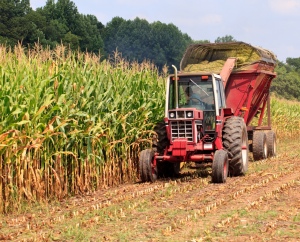

New research suggests that it should be possible to influence how bacteria manage nitrogen, in order to create better fertilisers for crops.
Nitrogen is an essential nutrient, but most plants cannot process it from the air. They depend on bacteria in the soil to provide them with nitrogen in a usable form. These bacteria convert nitrogen from the air and carbon from the soil into ammonia, which plants can then use to grow.
In a new study, researchers from Imperial College London and the Polish Academy of Sciences suggest that scientists could trick bacteria into producing more ammonia than they need to, providing an improved way of fertilising crops.

Better fertilisers could lead to increased crop production
They have identified a pathway inside the bacteria where carbon and nitrogen interact, determining how ammonia is managed.
The researchers believe it should be possible to interfere with this interaction so that the bacteria produce more ammonia. The research has important implications for agriculture. As world population levels increase, so does the demand for food, and therefore the need for increased crop production.
Professor Martin Buck, from the Department of Life Sciences at Imperial, who initiated the study with Professor Michael Stumpf, said: “Efficient nitrogen management is the key to efficient crop production. Inadequate supply of nitrogen results in poor growth and quality, while excessive fertiliser applications can have a costly environmental impact, such as dispersing into the groundwater and into the air as a greenhouse gas.
“Through understanding how bacteria manage their nitrogen economy, we could improve the supply of natural fertilisers, thereby increasing crop production while reducing the environmental impact.”
Dr Jorg Schumacher, the lead author of the study from Imperial’s Department of Life Sciences, added: “Usually, bacteria in the soil only produce only as much ammonia as they need to and that has been a major stumbling block in terms of using bacteria to create better fertilisers. If we know how to stop the bacteria from shutting off their production of ammonia, we can coax them into making more.”
The researchers reached their conclusions after analysing activity in a type of bacteria found in the gut, known as E.coli. These bacteria use the same kinds of mechanisms as the bacteria that process nitrogen in the soil.
The research was funded by the BBSRC and it is published this month in the journal mBio.
Supporters

Article text (excluding photos or graphics) available under an Attribution-NonCommercial-ShareAlike Creative Commons license.
Photos and graphics subject to third party copyright used with permission or © Imperial College London.
Reporter
Laura Gallagher
Communications Division

Contact details
Tel: +44 (0)20 7594 6701
Email: l.gallagher@imperial.ac.uk
Show all stories by this author




Leave a comment
Your comment may be published, displaying your name as you provide it, unless you request otherwise. Your contact details will never be published.